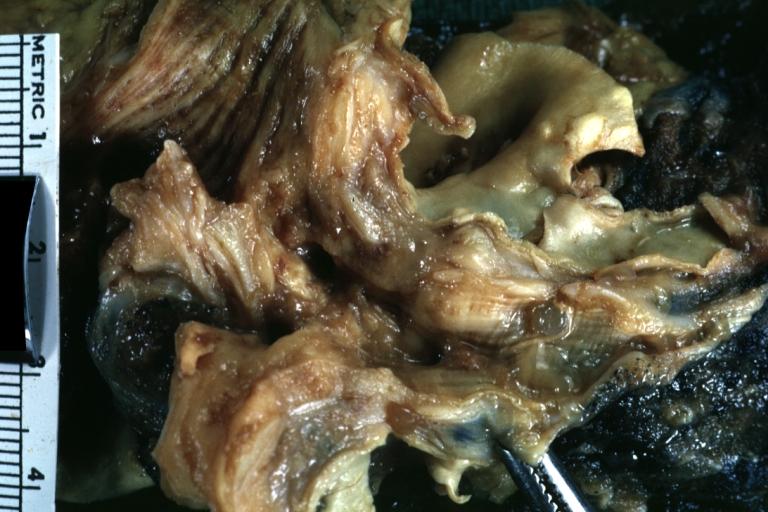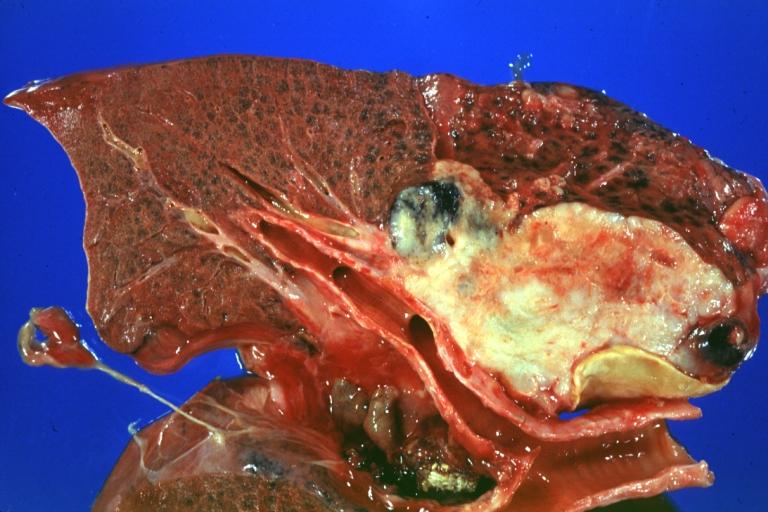Small cell lung cancer: Difference between revisions
No edit summary |
No edit summary |
||
| Line 24: | Line 24: | ||
'''Small cell carcinoma of the lung''' is an anaplastic, highly malignant, and usually bronchogenic carcinoma composed of small ovoid cells with scanty neoplasm. It is characterized by a dominant, deeply basophilic nucleus, and absent or indistinct nucleoli. There are admixtures of small cell lung carcinoma with other types of lung cancer. Small cell carcinomas are distinguished by their distinctive biological features, response to chemotherapy and radiotherapy, and by their nearly universal tendency to develop overt or subclinical metastases, which frequently eliminates surgery in most patients. | '''Small cell carcinoma of the lung''' is an anaplastic, highly malignant, and usually bronchogenic carcinoma composed of small ovoid cells with scanty neoplasm. It is characterized by a dominant, deeply basophilic nucleus, and absent or indistinct nucleoli. There are admixtures of small cell lung carcinoma with other types of lung cancer. Small cell carcinomas are distinguished by their distinctive biological features, response to chemotherapy and radiotherapy, and by their nearly universal tendency to develop overt or subclinical metastases, which frequently eliminates surgery in most patients. | ||
Without treatment, small cell lung cancer (SCLC) has the most aggressive clinical course of any type of pulmonary tumor, with median survival from diagnosis of only 2 to 4 months. Compared with other cell types of lung cancer, SCLC has a greater tendency to be widely disseminated by the time of diagnosis but is much more responsive to chemotherapy and radiation therapy. | |||
Because patients with small cell lung cancer tend to develop distant metastases, localized forms of treatment, such as surgical resection or radiation therapy, rarely produce long-term survival. With incorporation of current chemotherapy regimens into the treatment program, however, survival is unequivocally prolonged, with at least a 4- to 5-fold improvement in median survival compared with patients who are given no therapy. Furthermore, about 10% of the total population of patients remains free of disease during 2 years from the start of therapy, the time period during which most relapses occur. Even these patients, however, are at risk of dying from lung cancer (both small- and non-small cell types). The overall survival at 5 years is 5% to 10%. | |||
==Pathological Findings== | ==Pathological Findings== | ||
Revision as of 02:33, 16 January 2009
Template:DiseaseDisorder infobox Template:Search infobox Editor-In-Chief: C. Michael Gibson, M.S., M.D. [1]
Please Take Over This Page and Apply to be Editor-In-Chief for this topic: There can be one or more than one Editor-In-Chief. You may also apply to be an Associate Editor-In-Chief of one of the subtopics below. Please mail us [2] to indicate your interest in serving either as an Editor-In-Chief of the entire topic or as an Associate Editor-In-Chief for a subtopic. Please be sure to attach your CV and or biographical sketch.
Synonyms and related keywords: Oat Cell Carcinoma, Reserve Cell Carcinoma, Round Cell Carcinoma, Small Cell Lung Carcinoma, Small Cell Lung Cancer
Overview
Small cell carcinoma of the lung is an anaplastic, highly malignant, and usually bronchogenic carcinoma composed of small ovoid cells with scanty neoplasm. It is characterized by a dominant, deeply basophilic nucleus, and absent or indistinct nucleoli. There are admixtures of small cell lung carcinoma with other types of lung cancer. Small cell carcinomas are distinguished by their distinctive biological features, response to chemotherapy and radiotherapy, and by their nearly universal tendency to develop overt or subclinical metastases, which frequently eliminates surgery in most patients.
Without treatment, small cell lung cancer (SCLC) has the most aggressive clinical course of any type of pulmonary tumor, with median survival from diagnosis of only 2 to 4 months. Compared with other cell types of lung cancer, SCLC has a greater tendency to be widely disseminated by the time of diagnosis but is much more responsive to chemotherapy and radiation therapy.
Because patients with small cell lung cancer tend to develop distant metastases, localized forms of treatment, such as surgical resection or radiation therapy, rarely produce long-term survival. With incorporation of current chemotherapy regimens into the treatment program, however, survival is unequivocally prolonged, with at least a 4- to 5-fold improvement in median survival compared with patients who are given no therapy. Furthermore, about 10% of the total population of patients remains free of disease during 2 years from the start of therapy, the time period during which most relapses occur. Even these patients, however, are at risk of dying from lung cancer (both small- and non-small cell types). The overall survival at 5 years is 5% to 10%.
Pathological Findings
-
Histopathologic image of oat cell carcinoma of the lung. Gross fixed tissue opened bronchus at hilum showing tumor close-up.
-
Lung: Carcinoma: Gross natural color good photo of left upper lobe neoplasm extending into mediastinal pleura and surrounding portion of aorta node metastasis easily seen small cell carcinoma (unusual spindle cell areas)
References
See Also
External links
- Neuroimmunology - by Abid R Karim, Birmingham UK, at University of Birmingham Medical School
- Image at Tulane University

